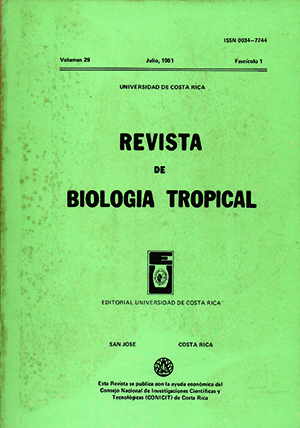Resumen
Se describe el comportamiento gregario de anidamiento de la avispa esfésida Stictia signata (L.) en Santarém, Brasil. Se ofrece información acerca de la estructura del nido, el comportamiento, registro de sus insectos de presa y la territorialidad del macho. Los machos defienden su territorio, el cual abandonan y reocupan repetidamente en el curso de una mañana.Citas
Alcock, J. 1975. The behaviour of the western cicada killer males, Sphecius grandis (Sphecidae, Hymenoptera). J. Nat. Hist., 9: 561-566.
Alcock, J. 1979. The behavioural con sequen ces of size variation among males of the territorial wasp Hemipepsis ustulata (Hymenoptera: Pompilidae). Behaviour, 71: 322-335.
Alcock, J. 1980. Natural selection and the mating systems of solitary bees. Amer. Sci., 68: 146-153.
Elliott, N., F. Kurczewski, S. Chaflin, & P. Salbert. 1979. Preliminary annotated list of the wasps of San Salvador Island, The Bahamas, with a new species of Cerceris (Hymenoptera: Tiphiidae, Scolüdae, Vespidae, Pompilidae, Sphecidae). Proc. Ent. Soc. Wash., 81: 352-365.
Evans, H.E. 1966. The comparative ethology and evolution of the sand wasps. Harvard University Press, 526 p.
Evana, H.E., & R.W. Matthews 1974. Observations on the nesting behaviar of South American sand wasps (Hymenoptera). Biotropica, 6: 130-134.
Lin, N. 1963. Territorial behaviour in the cicada killer wasp Sphecius speciosus (Drury) (Hymenoptera: Sphecidae). Behaviour, 20: 115-133.
Lin, C.S. 1971. Bionomics of Stictio carolina at Lake Texoma, with notes on some Neotropical species (Hymenoptera: Sphecidae). Texas J. Sci., 23: 275-286.
##plugins.facebook.comentarios##

Esta obra está bajo una licencia internacional Creative Commons Atribución 4.0.
Derechos de autor 1981 Revista de Biología Tropical


